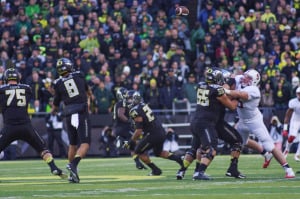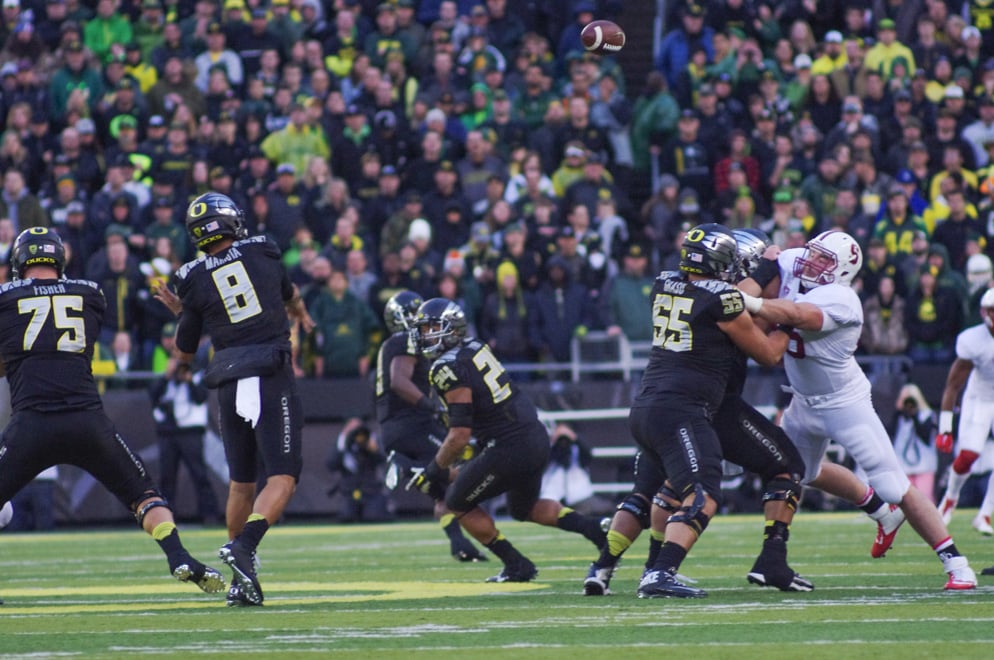Stanford got humiliated on Saturday night against the Oregon Ducks. This wasn’t exactly the Stanford of old – after all, against Arizona State the Cardinal had lost by two scores for the first time since 2011 – but nobody was expecting the Cardinal to lose 42-16, either; the Vegas spread only favored Oregon by about nine points, and the final score made The Daily’s predictors look silly (including yours truly). Still, though, the fact remains that the last time Stanford lost this convincingly, Andrew Luck was starting at quarterback…and now that I’ve said this, Stanford fans should know that they have been spoiled for the last five years.
The truth is, Stanford’s coaches actually did a pretty solid job with their game plan on Sunday. You can’t lose by 29 points and be on a level playing field with the other team – it’s not like David Shaw and Company blew the game with dumb playcalling. Oregon simply dominated, and equal teams don’t get dominated. This is a rebuilding year for Stanford. But since there’s going to be recriminations, I decided that I would explain a bit how the number one defense in the country was trashed within an inch of its life.
***
Stanford opened with its typical Oregon approach. The Cardinal switched from a 3-4 defense to a 4-2-5 nickel package against Oregon’s spread formations, rushed four players against the pass, played a conservative seven-man zone coverage, and forced quarterback Marcus Mariota to hand the ball off on the zone read. This was the scheme that held the offensively explosive Ducks to 14 points in 2012 and 20 points in 2013; in those years, as long as Stanford avoided giving up long touchdowns and generated a pass rush with its interior linemen, eventually Oregon’s offensive drives would implode – a sack, a fumble, an interception, a bad penalty or a long field goal. But Oregon carved up the Cardinal on its first few drives with quarterback scrambles and throws in the shallow and medium seams against Stanford’s soft zone defense. The Oregon inside run game wasn’t getting much at first, but it didn’t matter when Mariota had all day to throw.

And that’s the problem – Stanford’s rotation at defensive line, already thin, had barely enough players to be functional. You’re not going to be able to take on Oregon’s fast-paced, high-volume offense without a lot of depth, and Stanford had very little of it. Stanford was running a short rotation when the season began; by Saturday, defensive end Aziz Shittu was out for the season, and although star defensive tackle David Parry fought through injuries to play on Saturday, he wasn’t doing too much.
With so many injuries, Stanford could not get interior pressure against Mariota and force double-teams for long, especially with All-American center Hroniss Grasu on the other side of the ball. Oregon’s running backs didn’t run for much on the first two drives, but the offensive line was getting decent push against Stanford’s front seven. Meanwhile, Mariota wasn’t facing too much pressure on dropbacks and was carving up the Cardinal. Defensive coordinator Lance Anderson knew that he had to do something. The things he did worked. But defensive successes were immediately met with offensive adjustments.
***
In just two drives, Oregon methodically marched down the field twice. Marcus Mariota will take you apart if you give him time in the pocket; faced with an inability to generate an interior rush with four linemen, Anderson was forced to change from the tactics that had worked in the past. And honestly, he threw the kitchen sink at the Ducks. But Oregon head coach Mark Helfrich and offensive coordinator Scott Frost had been preparing for this game for a long time, and whenever Anderson went to one of his counters – different coverages, crashing on the zone read, corner and safety blitzes – Oregon’s offense adjusted in about two or three plays.
Rapid, almost in-the-moment adjustments were what ex-Oregon coach Chip Kelly was really legendary for – not the spread offense, because Oregon wasn’t the first team to run the spread option, but the variability in the offensive scheme. Now Helfrich has picked up that baton and is running with it all the way to Levi’s Stadium for the Pac-12 Championship game. Stanford will likely play in Levi’s, too, but it’ll be for the San Francisco (formerly the Kraft Fight Hunger) Bowl, not for national glory.
Oregon flashed some of the best offensive playcalling I’ve ever seen, and it shredded some smart defensive playcalls. I’ll highlight some things for you. (I don’t have video of the game, since only ESPN-televised games get online video and this one was on Fox, so unfortunately, no guarantees as to validity – but while I’m no Conor McFadden, I have a decent memory for X’s and O’s.)
Man coverage
One thing Anderson tried was a few man-coverage looks. Zone coverage doesn’t give up long touchdowns, but it’s also inefficient: Every player assigned to cover a zone on the field is one that you can’t use to rush the passer.
With some Oregon wideouts now one-on-one against Stanford’s cornerbacks, Mariota completed some nice throws. Worse yet for Stanford, Mariota nearly connected on a few early haymakers deep that could have put the game away early, but his great stats belied the fact that he was pretty shaky in the first half. Some brutal drops by Oregon receivers – including a couple sure touchdowns in the corner of the end zone – against both man and zone defenses also bailed out the Cardinal on several drives. These close misses rightly spooked Anderson into going away from man for much of the game. Let’s put it this way: Mariota did not have his best game, Kevin Hogan put on an absolute laser show on offense, and Oregon went into the half up by 11.
Forcing the zone read
Stanford needed to get pressure on Oregon while still playing zone coverage. As such, the defensive ends started blitzing. Normally, you have to be conservative with your ends: You never crash the ends against Oregon except on obvious passing plays. If Oregon’s called a read-option run play, an end blitz will allow Mariota to take the ball to the outside on an option keeper, where he’ll be one-on-one in space against a defensive back. Jordan Richards is an absolute stud at safety, but even he can’t stop Mariota at full speed every time.
This risky strategy gave Stanford some nice tackles in the backfield for a while, as the Cardinal ends and linebackers were able to blow by Oregon’s injury-struck offensive line. But Oregon started calling zone reads, and Mariota started carving up the Cardinal with his legs, registering some back-breaking runs.
Blitzing extra men
Faced with a rampaging Mariota, Stanford relented with the defensive ends, and Mariota didn’t keep the ball on the zone read much for the rest of the game. But Stanford started blitzing more linebackers and cornerbacks, and Oregon rapidly countered.
Stanford has good pass rushing defensive backs, but DB blitzes present the same problem – “rob Peter, pay Paul.” If you strengthen one area, you weaken another. In this case, blitzing defensive backs hurt Stanford’s short-range and intermediate pass coverage. So Oregon made quick throws to backs leaking out of the backfield, attacking the flats where the blitzing corners would have been. If Stanford’s linebackers followed the backs out of the backfield, then the middle of the pocket was open for Mariota to scramble with nobody to cover him. And worse, blitzing linebackers meant that there were fewer players to tackle running backs cutting upfield. Moreover, the players that didn’t blitz had worse tackling angles.
Winning the battle of attrition
Eventually, Oregon started opening up holes all across Stanford’s defensive front, as a thin Stanford defensive line got more and more tired. Now, Stanford’s offensive line was tiring out Oregon too. Both teams were getting more and more yardage on the ground by the end of the game, but Oregon was just gashing Stanford, and while Remound Wright’s 2-yard gains were turning into 5-yard gains, it wasn’t enough to keep pace.
Desperation: Cover Zero
Early in the fourth quarter, with Stanford down by two scores, the Cardinal defense found itself forced to make a goal-line stand to save the game. They went to a Cover Zero defense, with no safeties behind the line of scrimmage to clean up on defensive mistakes. (As opposed to Cover Two, which has two deep safeties, or Cover Three, which has three deep defensive backs, or Stanford’s standard Cover Four.)
Oregon didn’t have the numbers on offense to beat Cover Zero, but against an impending all-out blitz that focused on the interior, it was child’s play for Mariota to flash his blinding speed and take the ball outside and into the end zone. Stanford running Cover Zero is the black swan of college football plays, but the Cardinal didn’t really have any other choice at that point. Mariota knew exactly what he had to do, and his touchdown essentially ended the game.
***
Oregon outclassed Stanford, plain and simple. Stanford got Oregon to play their game for three quarters, and the Cardinal were still crushed. The Cardinal dominated time of possession, kept their defense rested and found holes in Oregon’s defense. They were “only” -1 in turnover margin. They lost by 29 points.
Don’t blame the players. Don’t blame the X’s and O’s. Blame the fact that Oregon was the better team. And there’s not too much you can do about that. Jim Harbaugh would not have beaten Oregon tonight. Chip Kelly would not have beaten Oregon tonight. Oregon deserved to win.
Contact Winston Shi at wshi94 ‘at’ stanford.edu.
